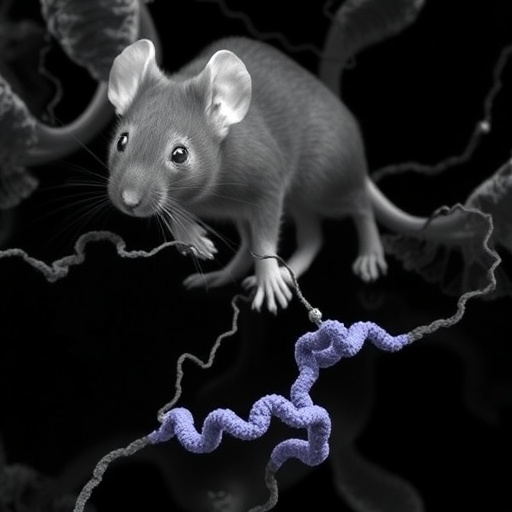In a groundbreaking advancement in neurodegenerative disease research, scientists have demonstrated that synthetic α-synuclein fibrils, specifically the strain known as 1B and its propagated form 1B^P, can replicate in mice and induce pathology closely resembling multiple system atrophy (MSA). Using a refined experimental approach, researchers overcame previous obstacles related to purification yields of fibrillar seeds, enabling in vivo studies with brain homogenates that contain these disease-driving particles. This pivotal discovery not only highlights the role of α-synuclein structural conformations in disease pathogenesis but also provides compelling evidence for the templated replication of prion-like protein strains in brain tissue.
Historically, understanding the molecular underpinnings of MSA, a devastating synucleinopathy characterized by glial cytoplasmic inclusions (GCIs), neuronal cytoplasmic inclusions (NCIs), and nuclear inclusions (NIIs), has been limited by challenges in isolating pathogenic α-synuclein fibrils at sufficient quality and quantity. The study circumvented this limitation by employing a tenfold diluted brain homogenate from 1B-seeded diseased transgenic mice, bypassing traditional sarkosyl-based purification steps that notoriously produce low fibril yields. This strategy allowed the inoculum to retain biologically active α-synuclein fibrils encapsulated in their native milieu, effectively seeding MSA-like neuropathology in wild-type (WT) mice after just six weeks.
Immunofluorescence analyses revealed the emergence of a spectrum of α-synuclein inclusions across diverse cellular populations, mirroring those observed with synthetic 1B fibril inoculations. The team identified Lewy neurites, NCIs, NIIs, GCIs, and glial nuclear inclusions (GNIs) consistent with pathological hallmarks of MSA. Crucially, these manifestations arose in recipient WT mice following intracerebral delivery of minimally processed brain homogenates containing 1B^P fibrils, underscoring the infectivity and propagation potential of these structurally defined α-synuclein seeds.
Intriguingly, comparison of the fibrillar structures elucidated through cryogenic electron microscopy (cryo-EM) reveals a striking architectural preservation between synthetic 1B seeds, the propagated 1B^P form extracted post-inoculation, and MSA brain-derived fibrils. Despite the sarkosyl detergent extraction applied in 1B^P purification, the pseudo-Greek-key fold—an intricate protein motif that defines the strain’s conformation—remains intact. This resilience emphasizes that the templated fold kernel, rather than extraneous unattributed density or interface rearrangements observed in 1B^P, dictates pathogenic strain identity and seeding capacity.
The study further dissects mutations within α-synuclein and their influence on 1B fibril replication. While alterations at the protofilament interface, such as H50Q, G51D, and A53 substitutions, fail to inhibit seeding, the E46K mutation abolishes pathogenic propagation by disrupting a critical salt bridge between Glu46 and Lys80. This molecular insight aligns with prior analyses of MSA ‘prions,’ reinforcing the importance of specific electrostatic interactions stabilizing the pseudo-Greek-key motif in templating disease-relevant fibril conformations.
Building on these findings, the authors propose that toxic propagation of MSA-like pathology is fundamentally encoded by closed N- and C-pocket conformations embedded within the fold kernel shared by 1B, 1B^P, and MSA fibrils. This structural feature likely accounts for the characteristic lack of thioflavin T (ThT) fluorescence observed in these fibrils—a phenomenon previously reported but poorly understood mechanistically. The closure of these pockets may thus represent a minimal yet essential structural determinant conferring pathogenicity and evading traditional ThT-based fibril detection methods.
Notably, other synthetic α-synuclein assemblies capable of seeding GCIs in vivo exhibit similar ThT invisibility, suggesting convergent structural motifs that drive disease propagation. This convergence indicates that the closed N- and C-pocket fold configuration may serve as a unifying molecular signature among diverse synucleinopathy strains with shared biological behavior, including their ability to template inclusion formation in neurons and glia.
The use of diluted, unpurified brain homogenates for inoculation represents a methodological innovation with significant implications for prion-like neurodegenerative disease research. It facilitates the direct assessment of biologically relevant fibrils within their native biochemical context and opens avenues for studying strain-specific neuropathology without artifacts introduced by harsh extraction protocols. The data convincingly demonstrate that structural fidelity of α-synuclein folds is preserved across propagation cycles, emphasizing templated misfolding as a critical mechanism underlying MSA and related disorders.
This research also adds a new dimension to the understanding of neurodegenerative disease heterogeneity, showing how subtle conformational differences in α-synuclein dictate pathology spectrum and host-cell tropism. By elaborating the hierarchy between fold kernels and peripheral structural adaptations in modulating pathogenicity, the study advances the conceptual framework for designing targeted therapeutics and diagnostics centered on fibril strain identity.
Importantly, the findings reinforce the prion paradigm applied to synucleinopathies, wherein distinct α-synuclein strains replicate conformations in vivo to propagate and cause specific neuropathological phenotypes. The elucidation of structural determinants underlying MSA-like pathology promises to accelerate biomarker discovery and rational drug design against these devastating and currently incurable diseases.
As a culminating point, the study’s integration of high-resolution structural biology with sophisticated in vivo models sets a new standard for dissecting the molecular basis of α-synuclein prion-like behavior. The ability to reproduce MSA-like inclusions in WT animals using synthetic fibrils and brain-derived seeds marks a critical milestone toward unraveling disease mechanisms and developing strain-targeted interventions.
Ultimately, this work substantiates the concept that the pseudo-Greek-key fold with its uniquely sealed N- and C-pockets forms the structural core essential for α-synuclein strains capable of seeding MSA neuropathology. By revealing the minimal structural unit required for pathogenic propagation, it propels the field closer to effective therapeutic strategies that may interrupt the relentless progression of synucleinopathies such as MSA.
Subject of Research:
Propagation and structural determinants of synthetic α-synuclein fibrils causing multiple system atrophy-like neuropathology in mice.
Article Title:
Synthetic α-synuclein fibrils replicate in mice causing MSA-like pathology.
Article References:
Burger, D., Kashyrina, M., van den Heuvel, L. et al. Synthetic α-synuclein fibrils replicate in mice causing MSA-like pathology. Nature (2025). https://doi.org/10.1038/s41586-025-09698-1
Image Credits: AI Generated
DOI: https://doi.org/10.1038/s41586-025-09698-1
Tags: brain homogenates in researchdisease-driving particles replicationglial cytoplasmic inclusions pathologyimmunofluorescence analysis in neurobiologyin vivo studies of MSAmultiple system atrophy researchneurodegenerative disease modelsneuronal cytoplasmic inclusions studyprion-like protein strainssynthetic alpha-synuclein fibrilstransgenic mice modelsα-synuclein structural conformations





